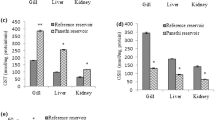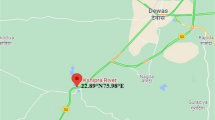Abstract
Some investigations were made on the canal water and inhabiting fish Channa punctatus at Kasimpur, district Aligarh (U.P.). It is a prime source for drinking, washing, and irrigation which was found to be receiving effluent from the adjoining Harduaganj Thermal Power Plant. The water samples were found to contain heavy metals, and the values obtained for Fe (8.71 mg L−1) and Ni (0.12 mg L−1) were beyond the recommended levels set by UNEPGEMS. C. punctatus was found to be the predominant fish in this canal. Fishes’ gills are directly exposed to the ambience; hence, the changes are expected to be more prominent. Among the analyzed heavy metals, bioaccumulation of Zn (500.41 mg kg−1 dry weight (dw)) was highest and Ni (13.93 mg kg−1 dw), the least. Increased levels of lipid peroxidation (LPO) as well as antioxidant enzymes superoxide dismutase (SOD), catalase (CAT), and glutathione-S-transferase (GST) were found in the gills of the test fishes. The level of reduced glutathione (GSH), a nonenzymatic antioxidant, was quite expectedly lower than that in the reference fish. The gills of inhabiting fishes contained several lesions like necrosis, epithelial lifting, lamellar fusion, hyperplasia, syneching, infiltration of lymphocytes, and bridging in gill tissue. The present study demonstrated that wastewater/effluent released from thermal power plant containing heavy metals has strong potential to affect the physicochemical properties of the water and well-being of aquatic living organisms.



Similar content being viewed by others
References
Abdul, Q., & Riffat, N. M. (2011). Heavy metals in eight edible fish species from two polluted tributaries (Aik and Palkhu) of the River Chenab, Pakistan. Biology of Trace Elements and Research, 143(3), 1524–1540.
Agency for Toxic Substances and Disease Registry (ATSDR) (2004). Agency for toxic substances and disease registry. Division of Toxicology, Clifton Road, Atlanta, Available at http://www.atsdr.cdc.gov/toxprofiles10/01/14.
APHA (American Public Health Association) (2005) Standard methods for the examination of water and wastewater analysis, 21st Edition. American Water Works Association/Water Environment Federation, Washington DC.
Ansari, T. M., Marr, I. L., & Tariq, N. (2004). Heavy metals in marine pollution perspective—a mini review. Journal of Applied Sciences, 4(1), 1–20.
Authman, M. M. N., Ibrahim, S. A., El-Kasheif, M. A., & Gaber, H. S. (2013). Heavy metals pollution and their effects on gills and liver of the Nile catfish (Clarias gariepinus) inhabiting El-Rahawy Drain, Egypt. Global Veterinaria, 10(2), 103–115.
Buege, J. A., & Aust, S. D. (1978). Microsomal lipid peroxidation. Methods in Enzymology, 52, 302–10.
Carpene, M., & Vasak, M. (1989). Hepatic metallothionin from goldfish (Carassius auratus). Comparative Biochemistry and Physiology, 92B(46), 3–8.
Claiborne, A. (1985). Catalase activity. In R. A. Greenwald (Ed.), CRC handbook of methods in oxygen radical research (pp. 283–284). Boca Raton: CRC.
Coetzee, L., du Preez, H. H., & Van Vuren, J. H. J. (2002). Metal concentrations in Clarias gariepinus and Labeo umbratus from the Olifants and Klein Olifants River, Mpumalanga, South Africa: zinc, copper, manganese, lead, chromium, nickel, aluminium and iron. Water SA, 28(4), 433–448.
Evans, D. H. (1987). The fish gill: site of action and model for toxic effects of environmental pollutants. Environmental Health Perspectives, 71, 47–58.
Farombi, E. O., Adelowo, O. A., & Ajimoko, Y. R. (2007). Biomarkers of oxidative stress and heavy metal levels as indicators of environmental pollution in African cat fish (Clarias gariepinus) from Nigeria Ogun River. International Journal of Environmental Research and Public Health, 4(2), 158–165.
Francisco, P. P., João, C., Ana, M. C., Conceição, F., Paulo, T., Luís, C., Ivo, C., Maria, M. O., & António, F. F. (2013). Oxidative stress responses and histological hepatic alterations in barbel (Barbus bocagei), from Vizela River, Portugal. Revista Internacional de Contaminación Ambiental, 29(1), 29–38.
Giardina, A., Larson, S. E., Wisner, B., Wheeler, J., & Chao, M. (2009). Long-term and acute effects of zinc contamination of a stream on fish mortality and physiology. Environmental Toxicology and Chemistry, 28(2), 287–95. doi:10.1897/07-461.1.
Gupta, A.K., Ahmad, I., Ahmad, M., (2014). Genotoxicity of refinery waste assessed by some DNA damage tests. Ecotoxicology and Environmental Safety. http://dx.doi.org/10.1016/j.ecoenv.2014.03.032i
Habig, W. H., Pabst, M. J., & Jakoby, W. B. (1974). Glutathione-S-transferases. The first enzymatic step in mercapturic acid formation. Journal of Biological Chemistry, 249, 7130–9.
Humason, G. L. (1979). Animal tissue techniques (4th edition). San Francisco: W.H. Freeman and Company. 661 pp.
Jabeen, F., & Chaudhry, A. S. (2010). Monitoring trace metals in different tissues of Cyprinus carpio from Indus River in Pakistan. Environmental Monitoring and Assessment, 170, 645–656.
Javed, M., & Usmani, N. (2011). Accumulation of heavy metals in fishes: a human health concern. International Journal of Environmental Sciences, 2(2), 659–670.
Javed, M., & Usmani, N. (2012a). Uptake of heavy metals by Channa punctatus from sewage fed aquaculture pond of Panethi, Aligarh. Global Journal of Research in Engineering (C), 12(2), 27–34.
Javed, M., & Usmani, N. (2012b). Toxic effects of heavy metals (Cu, Ni, Fe, Co, Mn, Cr, Zn) to the haematology of Mastacembelus armatus thriving in Harduaganj Reservoir, Aligarh, India. Global Journal of Medical Research, 12(8), 59–64.
Javed, M., & Usmani, N. (2013a). Haematological indices of Channa punctatus as an indicator of heavy metal pollution in wastewater aquaculture pond, Panethi, India. African Journal of Biotechnology, 12(5), 520–525.
Javed, M., & Usmani, N. (2013b). Investigation on accumulation of toxicants and health status of freshwater fish Channa punctatus, exposed to sugar mill effluent. International Journal of Zoology and Research, 3(1), 43–48.
Javed, M., & Usmani, N. (2013c). Assessment of heavy metal (Cu, Ni, Fe, Co, Mn, Cr, Zn) pollution in effluent dominated rivulet water and their effect on glycogen metabolism and histology of Mastacembelus armatus. Springer Plus, 2(1), 1–13.
Javed, M., & Usmani, N., (2014). Stress response of biomolecules (carbohydrate, protein and lipid profiles) in fish Channa punctatus inhabiting river polluted by Thermal Power Plant effluent. Saudi Journal of Biological Sciences. http://dx.doi.org/10.1016/j.sjbs.2014.09.021.
Jollow, D.J., Mitchell, J.R., Zampaglione, N., Gillette, J.R., (1974). Bromobenzene induced liver necrosis. Protective role of glutathione and evidence for 3,4- bromobenzene oxide as the hepatotoxic metabolite. Pharmacology, 11,151–69.
Kaviraj, A., & Das, S. (1999). Effects of fertilization on the deposition, partitioning and bioavailability of copper, zinc and cadmium in four perennial ponds of an industrial town. Indian Journal of Environmental Health, 41, 6–15.
Koca, S., Koca, Y. B., Yildiz, S., & Gurcu, B. (2008). Genotoxic and histopathological effects of water pollution on two fish species, Barbus capito pectoralis and Chondrostoma nasus in the Buyuk Menderes River, Turkey. Biology of Trace Elements and Research, 122(3), 276–291.
Lopez, E. L., Jacinto, Elías Sedeño-Díaz, Claudia, S., Liliana, F. (2011). Responses of antioxidant enzymes, lipid peroxidation, and Na+/K + −ATPase in liver of the fish Goodea atripinnis exposed to Lake Yuriria water. Fish Physiology and Biochemistry, 37, 511–522
Marklund, S., & Marklund, G. (1974). Involvement of the superoxide anion radical in the autooxidation of pyrogallol and a convenient assay for superoxide dismutase. European Journal of Biochemistry, 47(3), 469–474.
McCord, J. M. (1996). Effects of positive iron status at a cellular level. Nutrition Reviews, 54, 85–8.
Mohamed, F. A. (2008). Bioaccumulation of selected metals and histopathological alterations in tissues of Oreochromis niloticus and Lates niloticus from lake Nasser, Egypt. Global Veterinaria, 2, 205–218.
Nwajei, G. E., Obi–Iyeke, G. E., & Okwagi, P. (2012). Distribution of selected trace metal in fish parts from the River Nigeria. Research Journal of Recent Sciences, 1(1), 81–84.
Parvathi, K., Palanivel, S., & Mathan, S. (2011). Sublethal effects of chromium on some biochemical profiles of the fresh water teleost, Cyprinus carpio. International Journal of Applied Biology and Pharmaceutical Technology, 2(1), 295–300.
Ravanaiah, G., & Narasimha, M. C. V. (2010). Impact of aquaculture and industrial pollutants of Nellore district on the histopathological changes in the gill of fish, Tilapia mossambica. Indian Journal of Comparative Animal Phsiology, 28, 108–114.
Saeed, S. M., Shaker, I. M., (2008). Assessment of heavy metal pollution in water and sediments and their effect on Oreochromis niloticus in the Northern Delta Lakes, Egypt. 8th International Symposium on Tilapia in Aquaculture 489–490.
Selda, T. Z., & Kir, I. (2005). Comparative study on the accumulation of heavy metals in different organs of tench (Tinca tinca L. 1758) and plerocercoids of its endoparasite Ligula intestinalis. Parasitology Research, 97, 1412–1419.
Sesha Srinivas, V., & Rao, B. M. (1998). Chromium induced alterations in the gill of the freshwater teleost fish, Labeo rohita. Indian Journal of Comparative Animal Physiology, 17, 31–33.
Siddiqui, A. H., Tabrez, S., & Ahmad, M. (2011). Validation of plant based bioassays for the toxicity testing of Indian waters. Environmental Monitoring and Assessment, 179(1–4), 241–253.
Sivakumar, Rajesh kumar, Jayaprakash Mini, Natesan Munuswamy (2013). Impact of heavy metals on antioxidant activity in different tissues of milk fish Chanos chanos. International Journal of Applied Biology and Pharmaceutical Technology, 4, (1) 272–279.
Sreejai, R., & Jaya, D. S. (2010). Studies on the changes in lipid peroxidation and antioxidants in fishes exposed to hydrogen sulfide. Toxicology International, 17(2), 71–7. doi:10.4103/0971-6580.72674.
UNEPGEMS (United Nations Environment Programme Global Environment Monitoring System/Water Programme), (2006). ISBN 92-95039-10-6.
Tabrez, S., & Ahmad, M. (2009). Effect of wastewater intake on antioxidant and marker enzymes of tissue damage in rat tissues: implications for the use of biochemical markers. Food and Chemical Toxicology, 47, 2465–2478.
Tabrez, S., & Ahmad, M. (2011a). Oxidative stress mediated genotoxicity of wastewaters collected from two different stations in northern India. Mutation Research, 726(1), 15–20.
Tabrez, S., & Ahmad, M. (2011b). Mutagenicity of industrial wastewaters collected from two different stations in northern India. Journal of Applied Toxicology, 31, 783–789.
Tabrez, S., & Ahmad, M. (2011c). Components of antioxidative system in Allium cepa as the toxicity monitor of trichloroethylene (TCE). Toxicological and Environmental Chemistry, 93(1), 73–84.
Tabrez, S., & Ahmad, M. (2013). Cytochrome P450 system as potential biomarkers of certain toxicants: comparison between plant and animal models. Environmental Monitoring and Assessment, 185(4), 2977–2987.
USEPA, (2011). USEPA regional screening level (RSL) summary table: November 2011. Available at: http://www.epa.gov/regshwmd/risk/human/Index.htm, last update: 20th January, 2014.
Vineeta, S., Monika, D., Jai, P., & Sastry, K. V. (2007). Bioaccumulation of Zn, Cu and Cd in Channa punctatus. Journal of Environmental Biology, 2, 395–397.
Vutukuru, S. S., Chintada, S., Madhavi, K. R., Rao, J. V., & Anjaneyulu, Y. (2006). Acute effects of copper on superoxide dismutase, catalase and lipid peroxidation in the freshwater teleost fish, Esomus danricus. Fish Physiology and Biochemistry, 32, 221–229. doi:10.1007/s10695-006-9004-x.
Wilhelm, J. (1990). Metabolic aspects of membrane lipid peroxidation. Acta Universitatis Carolinae. Medica. Monographia, 137, 1–53.
Yousafzai, A. M., Douglas, P., Chivers, K. A. R., Ahmad, I., & Siraj, M. (2010). Comparison of heavy metals burden in two freshwater fishes Wallago attu and Labeo dyocheilus with regard to their feeding habits in natural ecosystem. Pakistan Journal of Zoology, 42, 537–544.
Acknowledgments
The authors wish to thank the Chairman of the Department of Zoology for providing the necessary facilities.
Author information
Authors and Affiliations
Corresponding author
Rights and permissions
About this article
Cite this article
Javed, M., Usmani, N., Ahmad, I. et al. Studies on the oxidative stress and gill histopathology in Channa punctatus of the canal receiving heavy metal-loaded effluent of Kasimpur Thermal Power Plant. Environ Monit Assess 187, 4179 (2015). https://doi.org/10.1007/s10661-014-4179-6
Received:
Accepted:
Published:
DOI: https://doi.org/10.1007/s10661-014-4179-6




